On a hot summer’s day in Queensland, Charlotte Dujardin delivered a wonderful educational masterclass at the QSEC indoor to a 2,500-strong crowd. With the view to developing a Grand Prix horse, Charlotte focused on the importance of good basics and explained that we shouldn’t fear making mistakes.
The weather was extreme at Caboolture, with temperatures in the high 30s and heavy humidity. Charlotte enthused how wonderful it was to be so warm as it surely beat the minus 5°C temperatures she left behind in England and said this was like heaven as she loves the heat. (We all thought, “Well you are welcome to come live in Australia!”) Awareness of the heat was taken into great consideration by Charlotte and the committee who ran the show. There was constant temperature monitoring of all the horses by vets and iced water and fans for cooling off during breaks in the sessions and after riding. It was handled with great consideration, and I can say that Charlotte adjusted her training accordingly.
If the weather had been cooler and less stressful for the horses and riders, we may have seen a more dynamic approach to the sharpness needed to the reaction times to the aids. It was often mentioned but not pressured on this day. Charlotte cleverly focused her attention on the more collecting phases of the training and the half-halts, frame and straightness rather than the more forward and extended paces. It was a refreshing approach and kept everyone’s attention despite the mopping of brows and the sweaty backs!
Charlotte has become an excellent giver of information and good at giving tips about the keyboard warriors who seem to delight in ripping into the slightest mistakes made by the top riders, and of late Lottie Fry and Charlotte herself. She was honest and humble and let everyone know that no matter how hard and correctly you train and prepare for competition, horses are horses and when confronted with huge crowds and atmosphere, minor mistakes creep in. That’s only normal. It’s not bad training, it’s simply lack of experience with big, emotional crowds and competition. She did say that she would love to see some of the warriors hop on and show how it’s done, drawing a chuckle from the crowd.
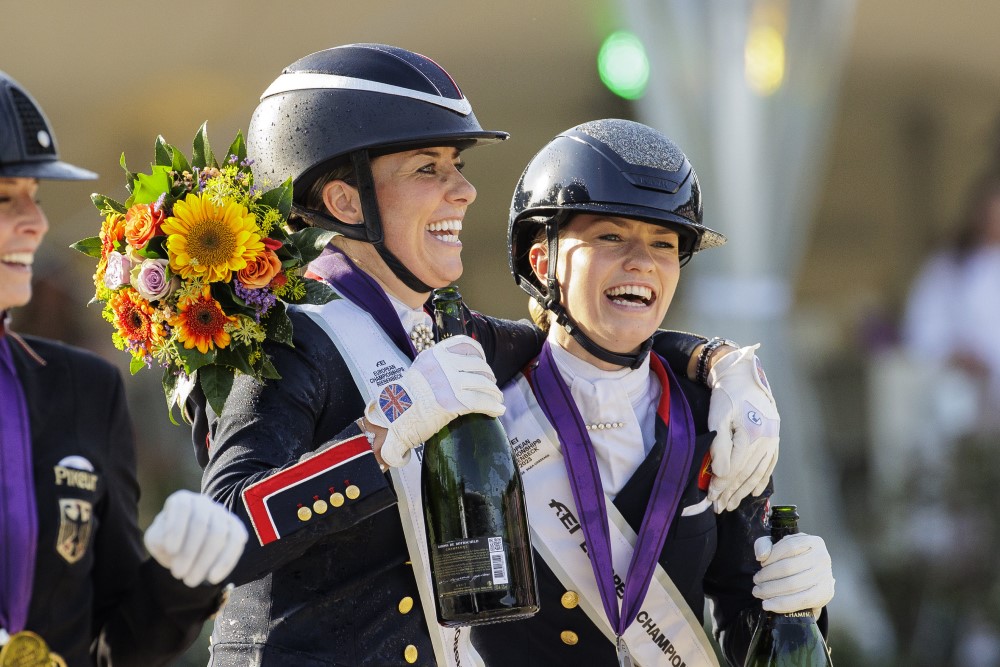
In one of the breakout discussions during an icing pause for the horses, Charlotte talked about the wonder that her daughter brings to her daily life. The realisation that there’s always tomorrow and not to go beating yourself up over minor worries in daily training. Her love in seeing her daughter grow was obvious and the joy infectious. She also let us know she was keen to be pregnant again by June so that she could ride at the Olympics and then be ready for the following spring to be back in the saddle. She laughed about there being no pressure on her husband about this plan!
DEVELOPING A GRAND PRIX HORSE
The simple, clear and disciplined yet calm training shone through in her delivery of her very ordered and structured sessions. There was no playing to the crowds, no time for this to interfere with her connection with the rider and horse. Her comments that were sometimes witty, funny and pointed were dispatched to the combination at hand to gain their attention and offer some light relief from the rigours and deep concentration she created. Charlotte is witty but honest and straight to the point.
Charlotte started by saying that occasions like this were the perfect experience for any horse towards competition. It is a good atmosphere without pressure and a great replication of a competition environment where the rider and horse can accustom themselves with no stress to totally succeed in every facet.
Her thoughts on choosing a horse with the view to getting to Grand Prix were simplistic and that everyone looks for different aspects, but no matter what, the trainable and accepting attitude to want to work and learn always takes priority. She chuckled that she loves them a bit wild and electric, and that to be a good young horse rider you have to be prepared for the unexpected!
“You can always make a
small trot big but you can’t as
easily make a big trot small!”
As for the paces, it’s important to have a good walk and canter. Not a walk that is too big, as it’s sometimes hard to collect in a good rhythm and to get to piaffe. By the same token, a bad walk is bad! The walk marks are coefficients and so a bad walk is not helpful at all. The canter needs to be uphill and active for pirouettes and changes and is important to collect. The trot isn’t a pace that Charlotte says is the most important – and remember you can always make a small trot big but you can’t as easily make a big trot small!
With balance and confidence and controlled muscular strength you can always introduce cadence and suspension to develop a trot. When looking at a new horse it is important to look at both sides for strengths and weaknesses. Of course, it is vital to ride as it’s more important to focus on the feel, not so much what you see. Charlotte went on to say that with the four-year-olds she rides, the trot is all rising with hardly any sitting. They are worked only four times a week and for 20 minutes. Not always in the arena but hacking out and on the roads, as where she has the stables it is quiet and easy to hack out. Good for the mind and the soundness.

She mentioned here that with the more advanced horses they are schooled on Monday, Tuesday, Thursday and Friday and on the other days hacked out or put in the water walker. Her horses are treated as athletes and are always fit and individually managed depending on their character and independent development. There are no hard and fast rules as to warm-ups; if a horse is feeling fresh, it’s better to warm up in a more collected frame and way of going than trying to stretch such a horse in the beginning, as that’s not that easy. Start on the bit and round and then go to the stretch.
Charlotte likes to start in canter, as with horses that aren’t that forward the canter helps with this, and then often the trot after canter is easier and better. Extended trot is not used every day, but working on balance, transitions, consistency in frame, and steadiness over the hindleg is where the focus is. It’s the attention to the half-halt and the ability to rebalance the horse that is of the utmost importance. To improve a movement, e.g. half-pass, it’s not about riding half-pass after half-pass, as this won’t improve anything; it’s about creating quick responses, transitions and engagement in work outside the half-pass. It is about response and adjustability at any moment in any movement that creates supple and balanced horses who can then gain confidence to produce expression.
FIRST SESSIONS

The first morning session saw Matthew Lord riding the wonderfully naturally uphill four-year-old chestnut mare, Remi Bodacious (Borsalino x Remi Love Song, by Locksley II), bred and owned by Cheryl O’Brien. The mare was green but full of presence and athleticism. She was very excited in the atmosphere with 2,500 people fanning themselves with their programs. Charlotte reiterated that she loves them like that… reactive! Horses need to want to work, as it’s at least six or seven years to Grand Prix and then four more to polish this. Charlotte loved the fire and attitude and gave the mare time to absorb the atmosphere and to realise it was all okay! This was to come from a calming pat and voice from Matthew. Charlotte commented that the praise needs to be heartfelt and not superficial. It’s important to love your horse’s attitude when a good decision is made, even if it happens to be minor. Minor can become major if taken the right way.
The natural canter was important and again she explained that the normal good trot rhythm is fine. It doesn’t need to be super fancy, as the tests are more about collection than extension, and essentially the piaffe and passage hold a huge number of marks.
With Matthew it was about gaining trust and confidence and at this age with an expressive and exuberant horse it was super important to hold her hand, so to speak. An unsteady contact at four is okay; its more about saying it’s okay and to try to maintain a straightness in all three gaits. It’s important to use the voice as a calming or exciting aid. The utmost importance is that you start with a horse that learns to turn off an outside rein. Don’t allow the increased flexion to allow the horse to bulge outwards, but straighten and turn off the outside rein.
Mistakes are fine as they allow for corrections, not punishment. Charlotte made a big correction with Matthew in that he needed to pay greater attention to the outside rein and never allow the mare to fall out across the line but to pick up the outside shoulder with a straightening outside rein and influence the shoulders to follow the line!

Sophia Redenbach, a young rider well known on the NSW show horse circuit, was next aboard a smaller brown mare, the five-year-old Hollands Bend Francine (Franklin x Regaliste, by Royal Classic). Charlotte admitted that her goal was to get horses to Grand Prix and even though she rides a few in young horse classes, it isn’t her real passion. She said that for young horse classes the walk is extremely important, yet she doesn’t mind if when looking for a potential Grand Prix horse the four-year-old’s walk isn’t enormous as sometimes horses with massive walks are tricky to collect and keep the four-beat clarity in the rhythm. Also, some with massive walks find it hard to get into the piaffe.
Charlotte pointed out the mare was far from straight and that she was constantly flexing left. Charlotte explained exercises to help this with a lot of work on the stiff right side. Left leg-yielding and shoulder-in on the right, while on the left side the thought of counter flexion to get the shoulders again around the turn. Sophia had become so used to the fact that the mare was in constant bend and flexion left in both directions that she had become complacent about achieving the straightness.
In the canter it was getting Sophia to have a better understanding of the half-halt to collect the mare for the walk transition. Every time she tried to collect the mare, she would fall into trot. Charlotte was patient and persistent to help Sophia gain a response and every time the mare trotted, it was back to canter and to obtain a better collecting response. Charlotte encouraged Sophia to take the risk! It was back to the four-year-old exercise of the 20-metre circle to the 10-metre circle with collection, because if the mare doesn’t collect she won’t be able to canter the smaller circle. Any reaction is better than none!
NOTHING WRONG WITH MISTAKES
Charlotte stressed that there was nothing wrong with making mistakes and taking risks, as this was the only way to train a horse. Mistakes make training possible, and each one is an opportunity to make corrections so that the correct responses happen. Sophia took the encouragement on board and some better transitions started to happen. It was about understanding how important straightness is, as it is impossible to get collection without this key factor!
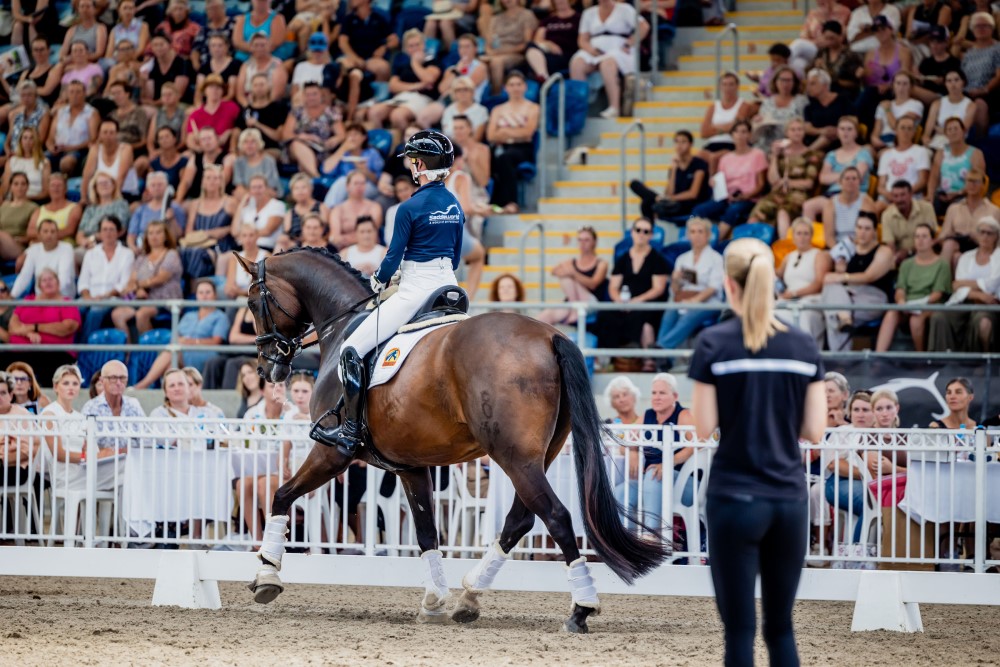
“Charlotte stressed that
there was nothing wrong
with making mistakes…”
The Elementary/Medium horse was the bay Warmblood gelding Fromancier (Fürstenball out of a Fürst Romancier mother). Charlotte explained that with the six-year-old it’s more about working forward into the lateral work. It’s about gaining strength and confidence in all the movements, but each horse is taken as an individual, and their mental and physical development will determine whether they look towards a six-year-old young horse class or are simply schooling for Grand Prix.
The general impression with this charming gelding was he needed to be more uphill. Her instructions were constantly about keeping the neck and shoulders up. Danielle was encouraged to make the trot work rising, as this helped with keeping him forward and in a very good rhythm. It was easy to see in the half-passes how the harmony and control were improved. It was in rising trot with the shoulder-in where Charlotte was constantly reminding her riders not to ride with over-flexion and too much bend. Be positive and ride forward in the shoulder-in as this helps keep the angle and control, reiterating to make certain the poll stays up and the horse in front of the leg.
Riders were reminded of being able to help through half-halts to encourage the sitting and the engagement. It was not ever about strength but about quick responsive aids and timing. Charlotte was very insistent throughout but especially with Danielle regarding riding correct corners, showing suppleness, bend and flexion, engagement and even more attention with this horse in the canter work as he always wanted to get longer and flatter and so to ride the corners in canter as if each one was a preparation for a canter pirouette.
It was easy to see that this really encouraged Fromancier to become more into self-carriage and sit on the hindleg in a better uphill shape and balance. It was a progression then to simply keep the bounce in the canter and not to allow it to get flat and push down, and then to keep trying to bring the canter back to a bouncing canter, preparing for a pirouette, and then go forward for two or three strides, and then come back and bounce the canter sharper with quicker reactions to the collecting phase of the canter. It was very interesting to see the development of the horse towards Grand Prix at this six-year-old level. Every corner was ridden with purpose to encourage the horse to become more supple and gain balance, self-carriage and strength.
On starting to work with the changes it again was simply straightness, suppleness and collection; if any of these ingredients are lacking in the canter, the changes will not proceed. Danielle was encouraged to make many, many transitions from canter to walk to canter then walk, and not too long in canter as he tended to get longer the more distance in canter was done. Just a few steps and walk. It was like getting a short and bouncy light canter and better sit-in and balance into the walk. When he became strong in the contact, Charlotte encouraged Danielle to move the bit, to vibrate it and to lift it up and never let the horse pull you forwards! With 7 meaning ‘fairly good’ it was encouraged that every movement was with the thought of making it for an 8 or 9. There isn’t time for complacency.
BALANCE & SELF CARRIAGE
As the class proceeded up the age groups, Charlotte expected more discipline from the riders in the way they rode every movement, corner line, half-halts and transitions. The focus and concentration to always creating a good balance and self-carriage was of the upmost importance. Without sharp reactions to all the aids, changes to the horse’s balance cannot be achieved. It takes time, and sometimes you need to go back and reiterate the horse’s sensitivity and confidence to the rider’s aids so that he becomes obedient to the slightest movement of the rider. He must listen to a “whispering aid”, and if not, shout once and go back to a whisper so he is always at the ready and attentive. This takes time and discipline from the rider at every ride… every ride! Never allow strong aids to start creeping in.
Again, when talking about mistakes, if your horse is dull to the leg and needs a quick touch to get a sharp reaction and maybe you get an overreaction, that’s fine. This overreaction with the dull horse, is good, but… then go back to being light again. Your horse must listen to your aids as if you are whispering, not shouting. And if they’re not listening to a whisper, shout, get their attention and whisper again. It was easy to see the improvement in this horse with Danielle paying attention to corners, lines and positioning again as well as expecting him to react to the first aid. He needed to be more uphill, and she needed to help lift his forehand, neck and hence poll higher. A great look at ways to engage and lighten a horse that tends to want to pull down. A great lesson.
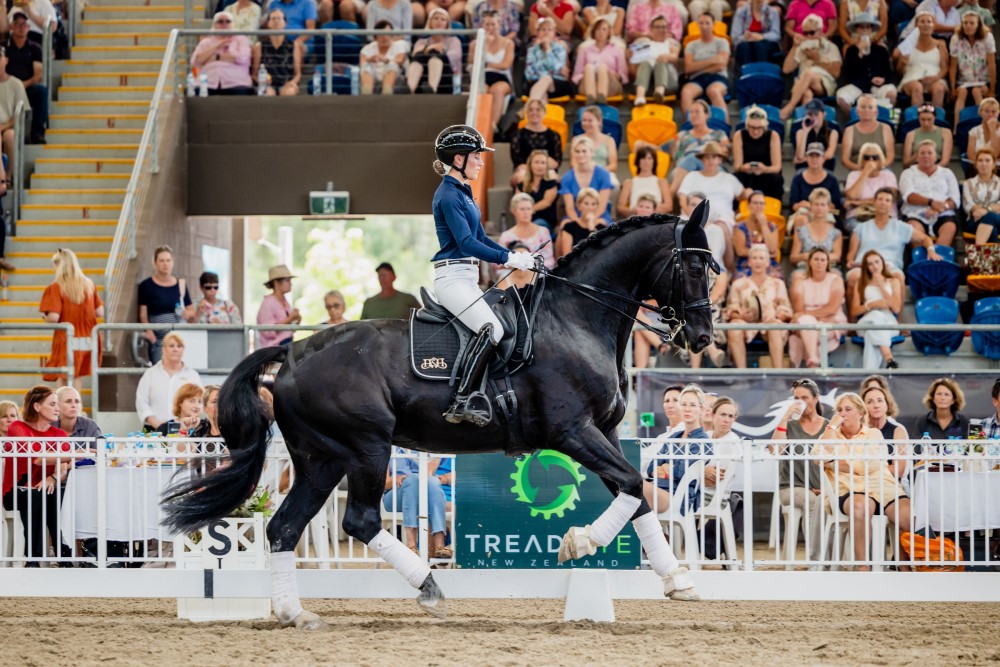
The stallion Keystone Kashmir (by Desperado out of a Jazz x Contango mare) was next in to strut his stuff and he certainly was uphill, impressive and on fire in a good way. He is owned by LiIlian Savage of Keystone Stud in Victoria. Kashmir was ridden by the then head rider at Keystone in Lucy Cochrane (NZ). Kashmir was purchased from the stables of Ad Valk and Emmelie Scholtens and this black stallion is a full brother to Ibiza. He was purchased after only his 20th ride, trained for a while with Australian Ben Conn then moved on to spend some time as a young horse in training with Ingrid Klimke before being brought back to Australia and Keystone by Lillian. Charlotte was very impressed with the stallion from the beginning. She said he was impressive, uphill, expressive, and a great mover.
Each horse must be taken on its own making, and Charlotte was encouraging this very uphill horse not to get short in the neck and high, but to lengthen and lower the neck. Lucy was encouraged to make many transitions from canter to walk, encouraging a lighter feeling in the bridle and a lower and stretching neck into walk. Then there was medium trot and canter on the long side and forward with bigger strides, not stronger strides, and to allow the neck to be a little more down.
The exercise that she chose to help with the flying changes was to be on a circle to the right, then, on a short diagonal and change to the left. The most important thing was to keep a positioning right before asking for the change to the left; it is important to keep the horse straight and in a balance to the new direction and move away from the new leg when you land in the new canter lead. It was a great exercise in control, straightening, positioning, activity and balance in the canter.
Think of the rhythm 1-2-3 then change, keep that rhythm in your head on 3; Lucy was encouraged to touch the horse with the whip and the leg for the change. It was imperative that the horse must not run through the bridle in the change otherwise the change will be late, the canter bouncing and more up-and-down than ground-covering in the beginning for the changes. Focus on the straightness, suppleness and the collection of the canter for good changes. You can’t miss any of these things if you want to have good flying changes. The changes were impressive, and the comment was made that the twos and one-tempi changes will look very impressive with this horse.
In the trot work again Charlotte encouraged a lower, not shorter, neck that was deep and down through the wither, and to push the nose out if he brings his neck a little too high and needs to stretch more downward again. Rising trot was encouraged in the lateral work in shoulder-in and travers. He had plenty of movement, and even though sometimes he may have felt a little lazy she was encouraged not to override.
Great attention was placed on the discipline in the transitions and the need for absolute straightness. It was very interesting that with this horse she felt he was of good quality and training, and really all she encouraged throughout every movement was for a longer, slightly flatter neck, and for him to be more in self-carriage and for the rider to do less. It was a super, super example of a Medium/Advanced horse and a horse with a huge potential returning to Australia.
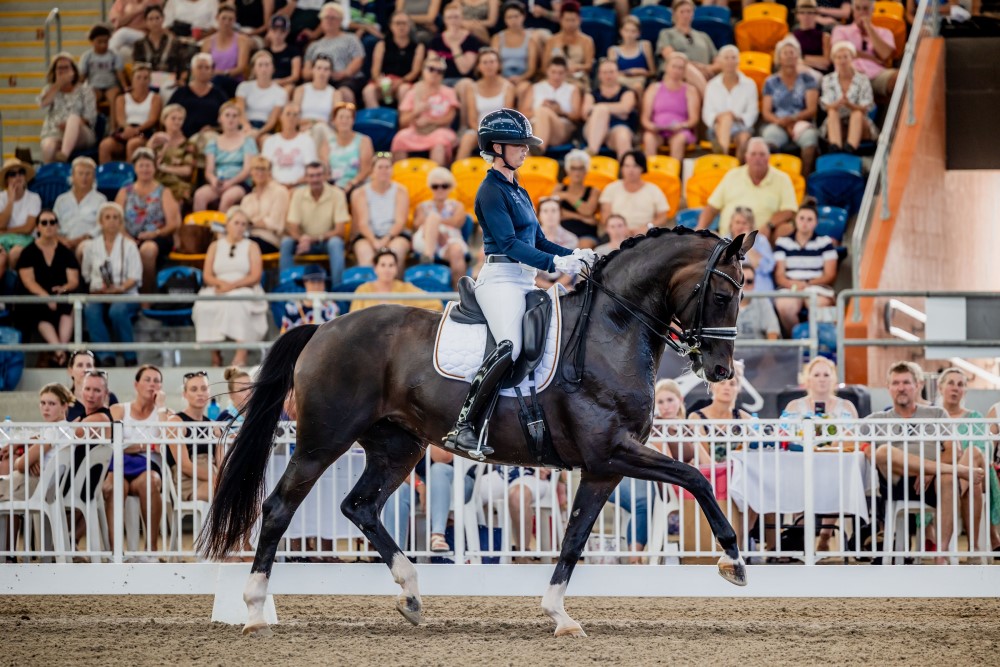
The next horse we saw was Revelwood Animation, bred by Amanda Shoobridge (by Ampere) and ridden by Victoria Luxford. This wonderful mare is at Small Tour level and working on the Grand Prix. Charlotte said that she often warms up in canter, and she did just this with Animation. Again, from the beginning this was in a good shape, but was still encouraged to keep the poll up. It was onto a 15-metre circle and straight into travers, keeping the poll up and the horse almost off the bit, with inside leg to outside rein and not allowing the tempo to slow down. Victoria was encouraged to get the canter more collected until it was almost on the spot with the head higher, being always around the inside leg. Of course, everything was done equally on both reins and always looking towards the equality of flexion, bend and suppleness and self-carriage on both reins.
A TALENT FOR PIROUETTES
This mare has a talent for pirouettes, and the exercise – after the circle in travers – was half-pass left to the centreline, shoulder-fore left, down the centreline to a half-circle, starting 8m, then 7m and so on, smaller and smaller in travers position. For half a working pirouette, and then straight back into the half-pass across to the quarterline and repeat the half circle/working pirouette again done on both reins.
Charlotte, again with discipline, was making certain that there was a correct number of steps, and to learn to count the steps as the number for a full pirouette is 6 to 8 (half pirouette to 4). At the end of the working pirouette, the rider should look up and ride shoulder-fore into the half-pass so as you are always keeping the inside shoulder up and keeping elastic expressive shoulders. If they lean into the bend and direction of the pirouette, the inside fore becomes quite grounded; if this happens it’s inside leg out of the pirouette with your inside aids to the outside rein to regain the balance to the outside. Again, with this higher level Charlotte expected quicker reactions to the aids in Grand Prix movements. The movements come up very quickly, so your horse must be very much sharp to the aids to make it easy to rebalance. Make hundreds of little corrections, making adjustments and rebalancing to set up every movement. Forward and shorter, quicker and slower, always with a supple body, neck and jaw.
With the changes Charlotte encouraged in training to do a lot of flying changes on the wall so you have a definite straight line and good visual and a feeling of organising the line. From the line on the wall, then go to the quarter line, and when that’s established, onto the diagonal line. This mare made lovely changes for threes and twos and Tori hadn’t really addressed the one-tempi changes so Charlotte took her to task with the corrections in the tempi changes for the straightness and the sharpness when it came to doing the ones. It was quite an easy progression. Tori was asked to do two ones on the long side followed by a half-halt and then change the outside into the inside.
The most important hint regarding making ones was that you can’t wait for the first change to be finished before you ask for the second. You’ve almost got to be an entire straight ahead of them, so the first change must be very sharp to your aid so you can get the next one back. It was kept that simple and Tori was amazed that she could make five and six one-tempi changes. She was really delighted.
ENJOYABLE CONCLUSION
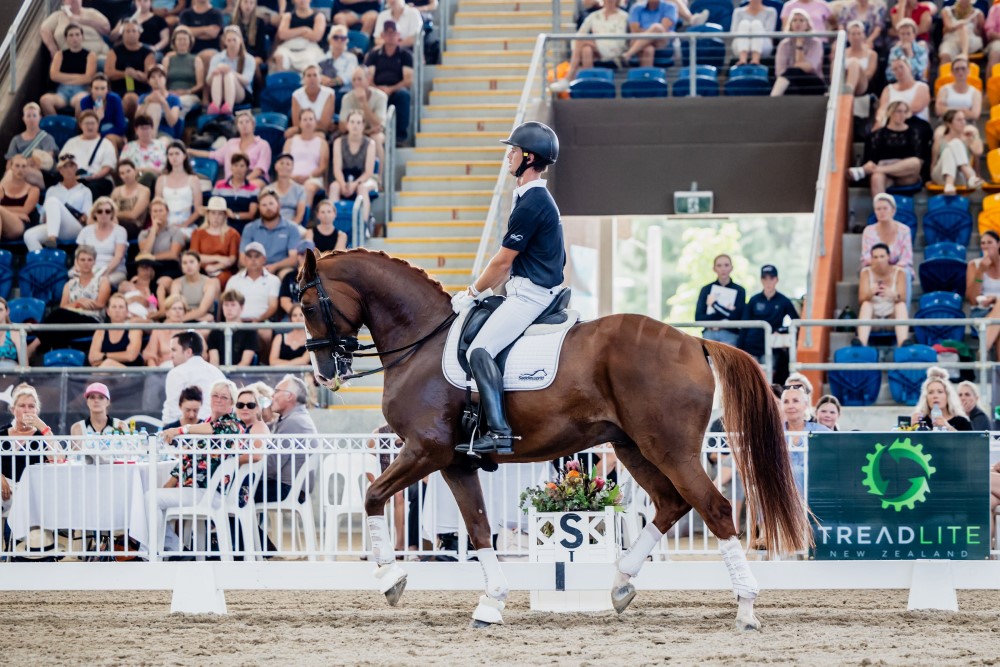
“Del Piero and Elliot Patterson
certainly made the
work look easy.”
The final horse was Del Piero ZF ridden by Elliot Patterson. This bright chestnut gelding (by De Niro out of Graf Landau, by Kinnordy). Charlotte wanted to show what makes up the movements of the Grand Prix and the attention was still on the simplistic exercises. But with this horse well established at Grand Prix it was about explaining the way to ride the movements, the preparations and a few exercises to help. It was sort of showing the final product of all the training, so it was an enjoyable way to end the day.
The first movement was from the Grand Prix, the zigzag in canter. The exercise she uses a lot, as does Carl, was to change the bend and flexion as soon as you start the half-pass so that you’ve got a new flexion and bend, and horse is moving away from the new half-pass direction before you make the change. This helps with the balance and stops the horse taking over in the change. The half-passes are good to do on the wall, six strides in and six strides out. This gives the rider the feel that you need to go equal distance in and out. It will show which half-pass is less fluent etc.
Again, it was about keeping the neck up and for Elliot not to carry the horse but to keep him in self-carriage. The two-tempi changes and the one-tempi changes were very fluent. Charlotte felt they were good, but could have more self-carriage, yet were very secure and brave. As with one-tempis, the crowd loved them and there was much clapping for a job well done.
On to the trot half-passes and it was explained how difficult it is. Del Piero lacked a little strength in the continuous cadence of the collected trot in the half-pass, and he was encouraged not to keep it too cadenced but to keep it moving sideways at this stage. Elliot was encouraged to lift him up and keep the trot forward, to lift up the forehand and then not to hold but to allow the forward movement while keeping the horse parallel.
It was interesting to see the difference immediately that this made and was a very good demonstration in what was a very difficult movement. Next was the ‘trot, halt, rein-back, trot’ movement and again it was important that the horse stayed very well on the aids and was not too grounded in the halt, but to keep the feeling of the feet ready to move. Plenty of practice was needed in this movement as it carries a lot of marks, and also shows submission, self-carriage and balance and is right under the judges’ noses to see the mouth and contact.
The last movement to be demonstrated was piaffe and passage, and Elliot was encouraged to keep the passage more forward, but not slowing down the tempo too much, in fact to keep the passage a little quick; once you find the passage, sit and do nothing. Don’t pull, sit very quietly and allow the horse to carry himself, especially in the piaffe never kick, lift him up a little in the bridle were her directions.
A lot of horses find the collection a little too much in the beginning in the piaffe and so to keeping a little forward wasn’t a problem at this stage. Piaffe with Charlotte is mainly trained under saddle and only occasionally in hand. It was commented that the extended walk had a good over-track but needs to reach a little bit more forwards and into the contact.
This was the end of a fabulous group of horses and demonstrations. Del Piero and Elliot Patterson certainly made the work look easy. This horse is inexperienced at this level but shows plenty of talent. It was very apparent with the good riding of Elliot in regards to keeping the horse on the hindleg all the time and never letting him run through the bridle.
This masterclass was exceedingly simplistic and easy to understand. There were no complications about any movement or any corrections. There was no hocus-pocus. There was no revving and excitement. It was very clearly simply a progression from the Preliminary and four-year-old horse through to Grand Prix by systematically paying attention, with great discipline to straightness, and strengthening the horse over the back into an upward, forward-thinking way with the shoulders.
Everyone walked away with a clear mind, and a very clear understanding of the simplicity of getting a horse to Grand Prix. It was an outstanding experience. Everyone was excited to get back on their own horses and focus and concentrate on the basics that have been harped on forever from all great coaches. There were no shattering new ideas, but Charlotte put it all in perspective and concentrated so well on each horse and rider and demonstrated great skill in explaining and getting the riders to have open and free minds and to enjoy their horses and never to worry about making a mistake. EQ
YOU MIGHT ALSO LIKE TO READ:
Maddy Vallender, Talented Teenager – Equestrian Life, March 2024

